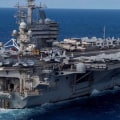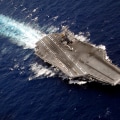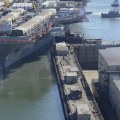The Suez Canal Authority has traditionally discouraged nuclear-powered vessels from navigating the canal due to public pressure and safety concerns. However, Egypt recently allowed a US Navy ship to pass through the canal, marking a breakthrough for the US. On rare occasions, the Suez Canal Authority has allowed a nuclear-powered vessel to transit the canal, but only after intergovernmental negotiation. The threat of a breakdown on board a nuclear power vessel while navigating the canal would result in the closure of the canal and a massive loss of revenue for the Canal Authority.
The legal issues that come with a nuclear-powered merchant ship operating with cargo on international voyages are complex and can be difficult to understand. Nation States have generally harmonized their laws related to ships through the IMO, but have seen no reason to harmonize their laws related to nuclear reactors through the International Atomic Energy Agency (IAEA). This means that when a nuclear reactor is built and operated in accordance with the laws and regulations of Country A is in country B, as is often the case with ships, there can be problems. After a container ship twice as heavy as a Ford-class aircraft carrier stopped traffic across the Suez Canal for nearly a week, the Department of Defense stressed that it is preparing for this type of scenario.
During a Monday press conference, Pentagon spokesman John Kirby said he could not discuss details about how the blockade of the container ship Ever Given impacted the US Navy. The Navy also declined to discuss the operational effects of the canal jam, but said it had other ways to help US Central Command in the Middle East. Passage through Suez is routine for East Coast carrier strike groups as a route to enter the US. The Eisenhower Carrier Strike Group is operating in the Eastern Mediterranean Sea and is expected to transit Suez in the near future, according to USNI News.
Reuters reported Monday that Ever Given had been evicted after a traffic jam of more than 400 vessels was delayed in their transit through the Suez Canal due to the blockade of the container ship. For ships trying to reach Europe or the United States, an alternative route would have forced them to sail around the Cape of Good Hope at the bottom of South Africa. At the briefing, Kirby praised Egyptian officials for working to release Ever Given, but said officials would likely need to assess whether the blockade had any other effect on the rest of the Suez Canal. Osama Rabie, president of the Suez Canal Authority, said that 422 vessels stopped due to the blockade could move across the canal within 3.5 days, according to a Reuters report. Rabie also reportedly told Egyptian state-owned Nile TV that officials had inspected the channel's background. Nuclear navies, whether Russian, Chinese, American, French, Indian or British, cling to their reactor officers, fearing that they might decide that running a power plant and coming home to see family every day is better than going to sea.
In some cases, reactor officers are lured back to sea with movie star salaries until they are sixty. The widest 33 m beam at waterline will coincide with 70,000 ton ships for which they are designed to clear way, although some ships with reinforced hulls are already using North Sea Route. Taymyr and Vaygach were built to meet international safety standards for nuclear craft and were launched in 1989 and 1990 respectively. This will include nuclear propulsion, floating nuclear power plants, small modular offshore reactors used for hydrogen production and maritime transport of SMR. Shipping companies considering future large nuclear-powered container ships will need to negotiate with Suez Canal Authority and port authorities. People are going to be as interested in unmanned nuclear merchant ship as they are in unmanned civil aircraft.
Currently, nuclear ships are only used by their own countries and do not participate in international trade. The same batteries would provide navigation control and short-range propulsion when commercial nuclear-powered ships arrive and depart ports that require deactivation of molten salt reactors aboard each commercial nuclear vessel. Areva TA (formerly Technicatome) supplies 150 MWt reactors based on K15 for six Barracuda submarines with shaft power of approximately 21.5 MW. It used 541 kg of U-235 for ten years and supplied power to Canal Zone for nine years with capacity factor of 54%. Russia built 248 nuclear submarines and five surface naval vessels (plus nine icebreakers) powered by 468 reactors between 1950 and 2003 and then operated about 60 nuclear naval ships. While traditional nuclear reactors are cooled with water, helium gas pumped at high pressure cools some modern high-temperature reactors. After Skate-class vessels reactor development continued and in US single series of standardized designs was built by Westinghouse and GE with one reactor feeding each vessel. Nuclear incidents such as Fukushima (Japan), Three Mile Island (United States) and Chernobyl (USSR - Russia) and stocks of semi-spent nuclear fuel rods have aroused strong public opposition to expansion of nuclear energy. A more powerful Russian LK-120 (originally LK-1 icebreaker Project 10510 Lider (or Leader)) will be powered by two RITM-400 reactors of 315 MWt each delivering 120 MW propulsion through four 37 MW generating turbines four electric motors and four propellers. The safety record of United States Nuclear Navy is excellent which is attributed to high level of standardization in naval power plants and their maintenance and high quality of Navy's training program.



